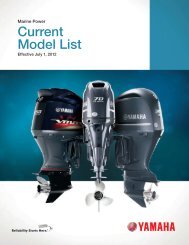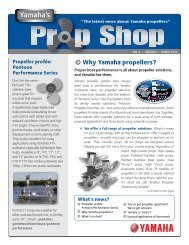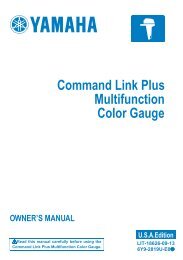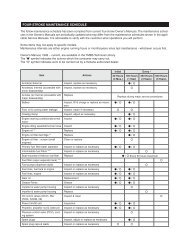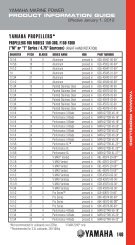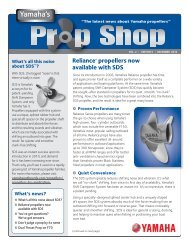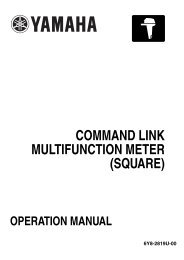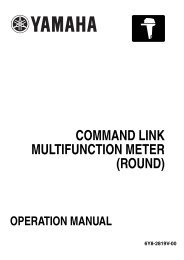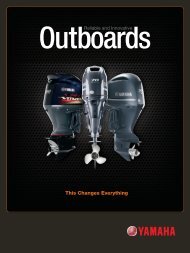Prop Shop VOL 1 EDITION 4 - Yamaha Outboards
Prop Shop VOL 1 EDITION 4 - Yamaha Outboards
Prop Shop VOL 1 EDITION 4 - Yamaha Outboards
You also want an ePaper? Increase the reach of your titles
YUMPU automatically turns print PDFs into web optimized ePapers that Google loves.
<strong>Yamaha</strong>’s<br />
“The latest news about <strong>Yamaha</strong> propellers”<br />
<strong>VOL</strong>. 1 | <strong>EDITION</strong> 4 | DECEMBER 2011<br />
<strong>Prop</strong>eller Testing<br />
In order to assure maximum<br />
performance from <strong>Yamaha</strong> and Turbo<br />
propellers, they’re tested here at<br />
our state-of-the-art Test Facility<br />
in northern Alabama. After the<br />
initial design phase of a propeller is<br />
completed and prototypes built, they’re<br />
put through a rigorous regimen that<br />
includes on-water testing on multiple<br />
platforms in multiple configurations.<br />
The results of each test is exhaustively<br />
documented and compared to desired<br />
performance, so that any necessary<br />
improvements can be made. This<br />
testing process repeats until <strong>Yamaha</strong><br />
is satisfied the propeller design meets<br />
not only their expectations, but yours.<br />
What’s News<br />
<strong>Prop</strong>eller Testing<br />
Endless <strong>Prop</strong>eller Solutions:<br />
Making the Grade<br />
You’ve got propeller questions<br />
We’ve got answers.<br />
Spotlight on Technology:<br />
Shift Dampener System (SDS )<br />
Keeping It Clean<br />
Unusual Application<br />
of the Month<br />
Endless <strong>Prop</strong>eller Solutions:<br />
Making the Grade<br />
“Endless <strong>Prop</strong>eller Solutions by<br />
<strong>Yamaha</strong>” represents the fact that<br />
<strong>Yamaha</strong> has a multitude of propeller<br />
solutions available…to fit most any<br />
boat. But do you really know what<br />
it takes to manufacture stainless<br />
steel propellers It’s a very involved,<br />
labor-intensive process that requires<br />
Wax mold<br />
a great deal of time. We thought we’d give you a glimpse.<br />
Ceramic shell<br />
Many of our stainless steel props<br />
are manufactured domestically by<br />
<strong>Yamaha</strong>’s wholly-owned subsidiary,<br />
Precision <strong>Prop</strong>eller Industries, Inc.<br />
Pouring molten steel<br />
Once a design is finalized and<br />
satisfactory testing of prototypes<br />
is completed, wax molds are built.<br />
Around each of these is built a multilayered<br />
ceramic shell, which is then<br />
dried and the wax melted out, leaving<br />
them hollow.<br />
Preheating the ceramic shell<br />
Stainless steel ingots of exact<br />
metallurgy are melted and poured<br />
(by hand!) into these preheated<br />
shells, which, when cooled, form the<br />
raw propellers.<br />
(continued on next page)
<strong>Yamaha</strong>’s<br />
Endless <strong>Prop</strong>eller Solutions: Making the Grade | continued<br />
After a trip through several stages of highly specialized grinding, the<br />
multi-stage finishing process produces the highly polished end products,<br />
which are then boxed and prepared for shipment.<br />
Since nearly all of the above processes are done by hand, it takes a lot<br />
of highly skilled labor to produce propellers,especially to the exacting<br />
standards of <strong>Yamaha</strong> and Turbo ® . Also, a very important element<br />
of “Endless <strong>Prop</strong>eller Solutions by <strong>Yamaha</strong>” is product quality and<br />
Grinding<br />
consistency, so each propeller undergoes<br />
a rigorous inspection process at the conclusion of each of these steps.<br />
Finishing<br />
It takes not only a great deal of skilled labor to make a stainless steel<br />
propeller, it takes time, and lots of it. If all goes just right throughout<br />
the entire process, it takes about 21 days. This means it takes longer to<br />
make the propeller than it does many boats!<br />
For more information, visit the “How They’re Made” section at turbo-props.com.<br />
Spotlight on Technology:<br />
Shift Dampener System (SDS )<br />
<strong>Yamaha</strong>’s patent-pending Shift Dampener System uses a unique,<br />
splined rubber hub and special splined aft spacer to distribute and<br />
absorb the forces, and the resulting sounds and vibrations that are<br />
normally associated with shifting an outboard into gear. The result:<br />
far quieter and smoother, ‘clunk free’ shifting. “Amazing” is the word<br />
most-often used to describe the result.<br />
SDS technology is currently available on all models of <strong>Yamaha</strong><br />
Saltwater Series XL® 3-bladed propellers for its 5.3L V8 F350; and<br />
all Saltwater Series II 3-bladed props and Saltwater Series HS4 <br />
4-bladed propellers for <strong>Yamaha</strong> V6s. All of these propellers are<br />
renowned for their durability and superior mid-range fuel efficiency<br />
on larger offshore boats, along with excellent anti-ventilation<br />
characteristics for better handling in rough seas. Now, they’re known<br />
for being super-quiet, too.
<strong>Yamaha</strong>’s<br />
You’ve got propeller questions We’ve got answers.<br />
Our continuing series, aimed at demystifying the world of propellers. Portions are reprinted with permission from<br />
<strong>Yamaha</strong>’s The Boater’s Log, Vol. 3, No. 14.<br />
Q. During a sharp turn, my outboard revs up but the boat loses speed. It seems like my three-blade<br />
propeller isn’t gripping like it should. What’s going on and how do I fix it<br />
A. It sounds like your propeller is ventilating – ingesting air from the water’s surface when the boat leans over<br />
in a turn. The propeller doesn’t work well in this aerated water, and as you suspected, the prop loses its grip –<br />
simply spinning rather than pushing the boat. This can also happen when trolling in heavy following seas.<br />
First, make sure your propeller’s blades are in good condition.<br />
They should be clean and free of knicks and cuts. Next, try<br />
trimming the engine down when you turn or are trolling in these<br />
conditions. This keeps the prop deeper in the water for better<br />
‘bite’. If the three-blade still ventilates, you could try a different<br />
style of three-blade prop with a larger diameter, more cup on the<br />
blade tips, or perhaps a four-blade wheel. Each of these<br />
modifications can help your prop stay hooked up in the<br />
described conditions.<br />
Ventilation<br />
Ventilation is when air is drawn in around the propeller<br />
blades. Normally, this causes a gain in RPM, but a loss<br />
of speed, since the propeller blades are not biting “clean”<br />
water. This most usually occurs during hard cornering or<br />
in certain water conditions, such as following seas.<br />
Controlled ventilation can be beneficial, though, in helping the engine gain rpm during hard<br />
acceleration. This is engineered into certain propellers, and is most-usually used on two stroke<br />
outboards. An example of this is the small holes in the side of the propeller barrel which allow<br />
exhaust to intentionally be drawn in around the blades at hole shot.<br />
This helps two stroke engines generate the higher rpm they need for<br />
proper hole shot performance. Four stroke engines typically<br />
don’t need them.<br />
For more information, consult the “The Boater’s Log”<br />
at yamahaoutboards.com
<strong>Yamaha</strong>’s<br />
Keeping It Clean<br />
Over time, depending on how you care<br />
for your propeller and the environment<br />
in which you use it,<br />
what most folks call<br />
“rust and corrosion”<br />
can appear on the<br />
surface of a prop.<br />
So why is this, and<br />
what can be done<br />
to prevent it<br />
First, it’s important to remember the<br />
propellers are stainless not stain-proof.<br />
We test and re-test our props to help<br />
ensure maximum resistance to corrosion<br />
while still maintaining the necessary<br />
hardness in metallurgy. But because<br />
there is a measure of iron contained<br />
in any stainless steel propeller, surface<br />
discoloration can appear over time.<br />
This surface discoloration is somewhat<br />
normal in certain instances. It doesn’t<br />
affect performance, just appearance.<br />
The best prevention is to thoroughly rinse<br />
the props with fresh water (and perhaps<br />
mild liquid soap) after each use. For more<br />
stubborn stains, you might also try a soft<br />
rag and spray-on household bathroom<br />
cleaner, hydrogen peroxide, or a mild<br />
rubbing compound. It’s very important,<br />
however, that you<br />
rinse the prop<br />
immediately<br />
and<br />
thoroughly<br />
with<br />
fresh, clean water<br />
after using these.<br />
Remember, since surface discoloration is<br />
not a defect in materials or workmanship,<br />
and the environment in which a prop is<br />
used and how it’s maintained is beyond<br />
our control, this condition is not covered<br />
under either the <strong>Yamaha</strong> or PPI Limited<br />
Warranty.<br />
Unusual Application of the Month<br />
What about propping at high altitudes<br />
Air at higher elevations is less dense<br />
and therefore contains less oxygen,<br />
which causes most engines to produce<br />
less power, including outboards. To<br />
help counteract this effect, you’ll<br />
need to use a propeller with less pitch<br />
than you would at, say, sea level, in<br />
order to produce proper wide open<br />
throttle rpm. But how much less<br />
Using a properly-performing propeller at sea level as a baseline guide, a<br />
very general rule of thumb is: From sea level to about 2500’ above sea<br />
level, no change in pitch is necessary. After that, drop about 1” of pitch<br />
size for every 1000’ of additional elevation to help keep the WOT rpm<br />
in the correct range.<br />
Here’s a very general run-down*:<br />
Up to 2500’ – same as sea level<br />
2501’ to 3500’ – deduct 1” of pitch<br />
3501’ to 4500’ – deduct 2” of pitch<br />
4501’ to 5500’ – deduct 3” of pitch<br />
5501’ & up – deduct 4” of pitch<br />
Also, avoid four-blades and real aggressive props with high rake angles.<br />
These make the engine struggle to create rpm. Less blade area and<br />
lower rake helps the engine develop rpm faster.<br />
You can find ‘baseline’ propeller values for various set ups in our<br />
Performance Bulletins http://www.yamaha-motor.com/<br />
outboard/products/perfbull.aspx<br />
*Pitch reduction amounts are estimates only, and are intended as a guideline only. Your results may vary. Large displacement<br />
engines, particularly late model fuel-injected four stroke V6s, typically require less pitch reduction for proper performance<br />
than smaller displacement engines. On-water testing is always best to determine proper performance.<br />
If you’d like more information i about which <strong>Yamaha</strong> propeller is right<br />
for your needs, contact your local authorized <strong>Yamaha</strong> Marine Dealer at<br />
http://www.yamaha-motor.com/outboard/dealers/dealerhome/home.aspx<br />
Also, feel free to check us out on Facebook at<br />
http://www.facebook.com/yamahaoutboards<br />
We’ll be happy to help you get pointed in the right direction.<br />
Turbo ® propellers are manufactured by Precision <strong>Prop</strong>eller Industries, Inc., a wholly-owned subsidiary of <strong>Yamaha</strong>.<br />
This document contains many of <strong>Yamaha</strong>’s valuable trademarks. It may also contain trademarks belonging to other<br />
companies. Any references to other companies or their products are for identification purposes only, and are not<br />
intended to be an endorsement.<br />
Due to <strong>Yamaha</strong>’s ongoing commitment to product improvement,<br />
we reserve the right to change without notice, equipment,<br />
materials, or specifications.<br />
© 2011 <strong>Yamaha</strong> Motor Corporation, U.S.A. All rights reserved.



